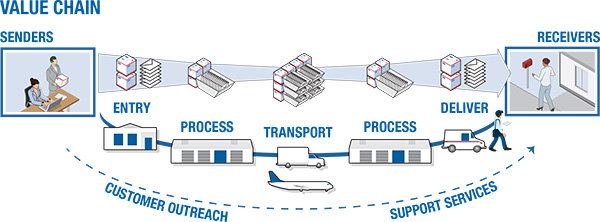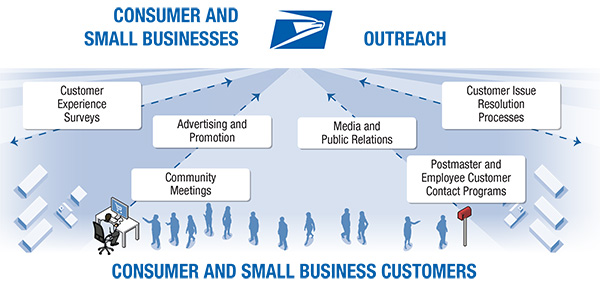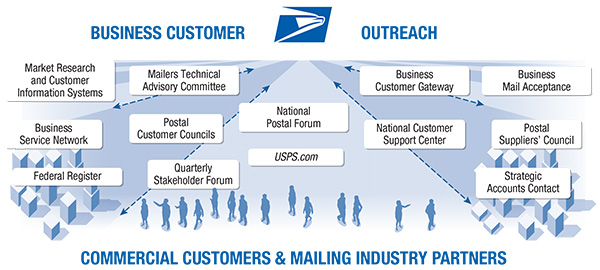Daily Operations Contribute to Success
Most strategic initiatives are built on existing processes, and much of the organization is involved in the day-to-day work of delivering service to our customers. The Postal value chain is a series of closely linked processes, supported by a common infrastructure.
The overall quality and cost of the system depends not only on the actions of the Postal Service, but also on the actions of mailers and mail service providers.

Customer Outreach
Our value chain begins with understanding and responding to customer needs. Most mail is generated by large commercial mailers, often with the help of mail service providers.
Since the Postal Service serves every business and household in the nation, the size and diversity of the customer base makes the outreach program one of the most extensive in the nation.
The Postal Service helps connect people and helps businesses grow by providing a trusted, reliable and cost-effective channel for communicating messages and shipping merchandise to their customers. Some programs reach consumers and small businesses as well as larger mailers and other stakeholders.
Formal outreach channels involving mailing industry stakeholders include the National Postal Forum, MTAC and the USPS Leadership Forum for stakeholder events.
Through these channels, Postal Service management receives valuable feedback on Postal products, services and programs.
The annual National Postal Forum attracts thousands of customers, suppliers and mailing industry partners who gather to share information and ideas, learn about new developments across the industry and meet with Postal officials.
Over 50 national mailing industry associations representing various segments of the industry are members of MTAC, which serves as a venue for the Postal Service to share and discuss technical information and issues concerning mail-related products and services.
The feedback and recommendations provided during the quarterly MTAC meetings help enhance customer value and expand the use of Postal products and services, benefitting mailers and the Postal Service.
USPS Leadership Forum for Stakeholders events are scheduled close to quarterly MTAC meetings, but are open to a broader group of stakeholders. Leadership Forum events allow attendees to hear directly from the Postal Service's senior leaders on current issues and developments.
Commercial and Consumer Outreach

What's in the Mail?
Part of the outreach program is making fundamental research on what is in the mail available to the mailing industry.
The Household Diary Study is an extensive panel study which tracks the content of mail received and sent by households, by application (bills and statements, payments, documents and correspondence, advertising, publications and packages) and by sender (industry).
This study, which has been ongoing since 1987, assists in the evaluation of trends and competitive positioning for mailers. (See http://about.usps.com/current-initiatives/studying-americans-mail-use.htm)
The CEO of the Mail and the Mail Moment
The Postal Service also conducts research that evaluates what happens to the mail when it is brought into the home.
About 37 percent of households have a strong "CEO of the Mail" who also is typically responsible for managing bill payment and for routine shopping. Mail is an integral part of his or her "job" — and this is true across generations.
Households can be helped to learn how to use mail more effectively — increasing the value of mail received. Mail-intensive households blend the use of multiple channels and are among the most desirable customers for many businesses.
